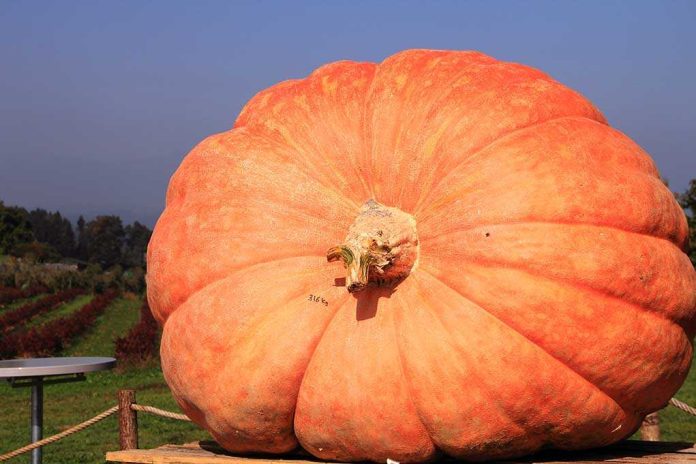
Your pumpkin pie may carry a toxic legacy—one that’s as invisible as it is unsettling, and no one at your Thanksgiving table is likely to suspect a thing.
Story Snapshot
- Independent labs and consumer groups have detected toxic heavy metals and pesticide residues in pumpkins and pumpkin products.
- Regulatory investigations and media coverage have ignited public concern, particularly for children and pregnant women.
- Retailers are responding with advisories and selective product removals, though no sweeping recalls have occurred—yet.
- The pumpkin’s newfound notoriety is forcing a reexamination of food safety standards and agricultural practices.
Pumpkins: From Festive Icon to Food Safety Flashpoint
Long before pumpkin spice lattes and porch jack-o’-lanterns, pumpkins stood as a symbol of harvest abundance. Today, that familiar orange gourd is making headlines for a less wholesome reason: recent lab tests reveal some pumpkins and pumpkin-based foods contain elevated levels of heavy metals—like lead and cadmium—and persistent pesticides. These findings, publicized by consumer advocacy groups and investigative journalists, shatter the perception of pumpkins as a universally safe autumn staple. The greatest risk falls on children and expectant mothers, whose developing bodies are especially vulnerable to toxic exposure.
Consumer advocacy groups began raising red flags in 2023 after independent labs detected heavy metals in pumpkin samples from major grocery chains. By fall 2024, media coverage intensified, spurring regulatory agencies to launch their own investigations. The U.S. Food and Drug Administration (FDA) and the European Food Safety Authority (EFSA) issued statements acknowledging the problem and promising a thorough review of current safety standards. Major retailers, keen to avoid liability and public backlash, quickly responded by pulling select pumpkin products off shelves or issuing precautionary advisories. For many shoppers, these developments marked the first time they considered that a simple pumpkin pie or festive soup could harbor hidden dangers.
How Did Pumpkins Become Contaminated?
The roots of the problem begin, quite literally, in the soil. Industrial agriculture’s reliance on chemical fertilizers and pesticides increases the risk of contaminant uptake by pumpkins. Like other squashes and root vegetables, pumpkins absorb heavy metals from polluted soil and water. This bioaccumulation process is invisible to the naked eye and undetectable by taste or smell. Testing reveals that even pumpkins labeled as “natural” or “locally grown” are not immune if the soil is compromised. The seasonal surge in pumpkin consumption in North America and Europe amplifies the risk, especially when pumpkins are processed into purees or baby foods consumed in large quantities by vulnerable populations.
Previous food safety scares—such as recalls of baby foods and juices due to heavy metal contamination—set the stage for today’s pumpkin controversy. Consumers, regulators, and advocacy groups are locked in a familiar tug-of-war: how much risk is acceptable, and who is responsible for ensuring safety? Regulatory standards for heavy metals and pesticides in food vary widely by country, and some experts argue that even so-called “safe” limits may not adequately protect those most at risk.
Stakeholders Clash Over Consumer Safety
The pumpkin crisis draws together a cast of powerful and competing interests. Regulatory agencies like the FDA and EFSA hold the authority to set and enforce safety limits. Consumer advocacy groups—such as Consumer Reports and the Environmental Working Group—push for stricter oversight and greater transparency. Pumpkin farmers and agricultural associations, meanwhile, worry about market access and consumer trust. Retailers and food manufacturers scramble to protect their brands and avoid costly recalls. Independent labs and academic researchers provide the scientific backbone, with evidence-based risk assessments and soil studies that expose gaps in the food safety net.
Power dynamics play out in public statements and backroom negotiations. Regulators face mounting political pressure to act swiftly, while growers and retailers fear economic fallout. Advocacy groups leverage media attention to keep the issue in the headlines, ensuring the pumpkin’s toxic secret isn’t swept under the rug once the autumn rush fades.
Health Risks, Economic Fallout, and the Future of Pumpkin
Short-term consequences are already visible: anxious consumers question pumpkin purchases, and some retailers report declining sales. Families with young children—those most vulnerable to chronic low-level heavy metal exposure—are especially wary. Public anxiety about food safety may ripple outward, affecting trust in other produce and processed foods. For pumpkin growers and food producers, the specter of recalls and lost sales looms large, threatening livelihoods and entire supply chains.
Long-term, the pumpkin’s toxic secret could reshape industry practices. Stricter regulations, improved soil testing, and a shift toward organic or certified-safe production methods are all on the table. The episode highlights the need for harmonized international standards and more comprehensive risk assessments that consider cumulative, multi-source exposures. As the pumpkin’s reputation hangs in the balance, one thing is clear: the demand for food transparency isn’t seasonal, and the public’s appetite for answers grows with every unsettling headline.
Sources:
Worker Pleads Guilty After Massive Whiskey Heist










